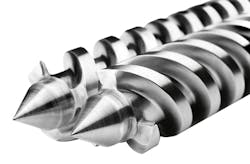Laser cladding extends life of extrusion screws by 300%
OPGLABBEEK AND KALKEN, BELGIUM – Extruding pet-food bulk granules in smaller pieces is a mechanical process. Two extrusion spindles—rotating next to each other in the reverse direction—crumble granules along the advancing threading of the spindles. The spindles' coating needs to withstand the high dynamic frictional forces that occur during the extrusion process.
The challenge is to find superior coatings to keep extrusion spindles in operation for a longer period. In this regard, Laser Cladding Venture (LCV), together with Vatis, has achieved a breakthrough—a metal LCV CorroSlide coating, applied through robotized laser cladding, exhibits significantly higher wear resistance than with conventional coating technologies.
Extending spindle operation time 300%
The laser cladding method ensures the optimum formula of carbide coating, which connects with the extrusion spindles through metallic bonding. The undissolved state of the carbides is responsible for an extremely strong attachment when compared to mechanical or chemical coatings. In addition, the laser cladding coating itself consists of an optimized carbide structure that makes the coating extremely durable and hard. This way, laser cladding positions itself as a cost-efficient alternative to high-velocity oxygen fuel (HVOF) thermal spraying, nitration, and hard-facing.
The pet food manufacturer typically protects its spindles conventionally through hard-facing. Using this coating method, the spindles last two cycles. With the metallic coating applied through laser cladding, the spindles operate as much as 4000 hours without revision, resulting in a 300% extension of the spindle operation period compared to the hard-facing coating method (FIGURE 1). Compared to HVOF thermal spraying, the extrusion spindles last at least 3X longer and, when compared to nitration, as much as 8X longer (FIGURE 2).
With robotized laser cladding, LCV succeeds in extending the life of extrusion screws for an international manufacturer of pet food by 300% compared with conventional hard-facing methods. This enables the pet food manufacturer to save considerably on maintenance and investment costs.


